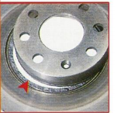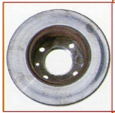Analysis of common brake disc failures
2023-08-01 08:47:56

Appearance: The contact surface of the brake disc and the hub is deformed or the mounting holes are cracked.
Cause: The brake discs are not tightened in the correct order and the tightening torque used is not sufficient.
Impact: Significant vibration is generated during initial braking.
Solution: Replace the brake discs and tighten them in the correct order of installation and according to the manufacturer's recommended torque requirements.

Appearance: Deformation of the contact surface position of the brake disc to the hub and/or cracking around it.
Cause: Excessive tightening torque used for the locating screw.
Impact: From the initial braking, vibration occurs during the braking process.
Solution: Replace the brake disc and avoid using excessive tightening torque. Positioning studs are for brake disc positioning only.

Appearance: The brake disc is broken or deformed at the contact location with the hub.
Cause: Over-tightening the brake discs and failing to tighten them according to the manufacturer's recommended tightening torque and sequence.
Impact: Cracks develop at the contact point between the brake disc and the hub. Braking fails completely.
Solution: Check the brake system and its associated components thoroughly. Replace all defective parts, install new brake discs, and tighten the discs according to the manufacturer's recommended tightening torque and sequence.

Appearance: The surface of the wheel is very dirty/ or rusty.
Cause: When installing the brake disc, the dirt on the wheel surface will cause deviation of the brake disc installation position, which will cause irregular contact between the brake pads and the surface of the brake disc, and uneven wear of the brake disc.
Impact: Deviations in brake disc thickness can cause the surface of the disc to oscillate, resulting in noise and vibration. This effect will increase as the disc continues to be used.
Solution: Remove the brake discs and carefully clean the hub and disc surfaces of any dirt or rust. Inspect the hub surface for deformation or other damage. Replace and tighten the brake discs according to the manufacturer's recommended tightening torque and sequence.

Appearance: Blue and dark spots appear in some areas of the brake disc, which is a partially overheated surface of the disc.
Cause: Excessive wheel runout. The uneven contact between the brake disc and the brake pad produces excessive oscillation, which causes the situation to heat up and then produces the blue phenomenon.
Impact: Gradual increase in noise and vibration.
Solution: Correct the wheel runout and make sure that the wheel runout is within the correct tolerance.

Appearance: The small end of the brake disc is torn or broken from the braking surface of the brake disc.
Cause: Mechanical stress due to misalignment of the brake disc centers during assembly. Incorrect assembly or positioning of the brake caliper and disc results in continuous asymmetrical wear of the brake surface on both sides of the disc, eventually causing the small end of the disc to tear away from the brake surface of the disc.
Impacts: Initially, the braking process is noisy and vibrates loudly, and when the small end of the disc breaks off the disc's braking surface, mechanical failure results.
Solution: Check the brake system and its associated components thoroughly.
Replace all defective parts, install new brake discs, and tighten the discs according to the manufacturer's recommended tightening torque and sequence. Before installing the brake discs, check the position of the brake caliper body on the axle.

Exterior: The brake discs show relatively deep scratches.
Cause: Scratches on the brake disc are caused by friction particles between the brake pads and the disc. These particles may be from substances outside the brake system (road, dust and water), or from poorly mixed friction materials.
Impact: Generates noise during braking and normal operation of the vehicle; also reduces braking efficiency due to reduced braking contact surface.
Solution: Please replace the brake pads and brake discs.

Appearance: The brake discs have uneven wear on the brake contact surfaces, blue spots in their centers, and possible cracks.
Cause: Incorrectly installed brake calipers and/or pads can result in inconsistent angles of the pads relative to the brake discs and different rates of wear on each side. Severe localized overheating of the friction contact surface is the cause of the blue spots.
Impact: Excessive hot spots can cause gradual vibration and may also reduce braking efficiency.
Solution: If necessary, inspect and service the brake calipers. Replace the brake pads and check that the type and shape of the new padsmatch the application.

Appearance: Contamination on the surface of the brake disc - shiny or produces dark spots.
Cause: Deposits of friction material have been transferred to the surface of the brake disc. This is often the case if poor quality brake pads are installed.
Impact: Vibration, reduced braking efficiency and effort when applying the brake pedal.
Solution: Install high quality brake pads and choose a friction material that is suitable for the brake and the vehicle.

Appearance: Uneven brake pad wear. One side of the brake pad is severely worn, while the other side is lightly worn.
Cause: The brake caliper is stuck. The brake pads on one side arecontinuously rubbing against the disc, causing the pads to wear into the metal backing plate. The side of the metal backing plate that rubs
against the brake disc will be badly scratched, while the other side of the disc and the brake pads are in almost new condition.
Impact: Creates constant harsh noise and vibration, and also reduces braking efficiency. Imbalance occurs when the vehicle is braked Makes the vehicle run off course.
Solution: Please check, replace or repair the brake caliper. If necessary, brake pads and discs will also need to be replaced.
Tel:+86-18633738852
Email:bin.fu@czthbrakes.com
Fax:+86-0317-5259727
Address:Fengjiakou Town Industrial Zone, Nanpi, Cangzhou City, China






